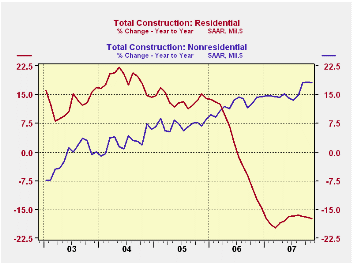 Global| Jan 02 2008
Global| Jan 02 2008U.S. Construction Spending Rose Slightly
by:Tom Moeller
|in:Economy in Brief
Summary
The value of construction put in lace rose a slight 0.1% during November following a 0.4% downtick during October. These, and other, small monthly changes this year have left the value of construction put in place down just 0.2% year [...]

The value of construction put in lace rose a slight 0.1% during November following a 0.4% downtick during October. These, and other, small monthly changes this year have left the value of construction put in place down just 0.2% year to date.
Gains in nonresidential building activity have cushioned weakness in the residential area. Nonresidential building activity rose 2.1% in November and that pulled the year to date gain to 16.1%. Year to date, building in the lodging area is up a whopping 71.4%. Office construction is up 17.1% and commercial building rose 8.8%.
Residential building in November fell another 2.5% m/m and year to date activity is off 16.5%. Building of new single family units fell 5.0% during November. Year to date the decline totals 26.7%. Again to the upside was spending on improvements. It rose 0.7% in November and increased 3.9% ytd.
During the last twenty years there has been an 84% correlation between the q/q change in the value of residential building and its contribution to growth in real GDP.
Public construction spending also has been strong this year and rose 2.5% during November. That pulled to ytd gain to 12.5%. Construction on highways & streets rose 1.9%, 12.8% ytd. The value of construction on highways & streets is nearly one third of the value of total public construction spending. Construction spending on education also has been fir m and up 11.1% this year.
These more detailed categories represent the Census Bureau’s reclassification of construction activity into end-use groups. Finer detail is available for many of the categories; for instance, commercial construction is shown for Automotive sales and parking facilities, drugstores, building supply stores, and both commercial warehouses and mini-storage facilities. Note that start dates vary for some seasonally adjusted line items in 2000 and 2002 and that constant-dollar data are no longer computed.
| November | October | Y/Y | 2006 | 2005 | 2004 | |
|---|---|---|---|---|---|---|
| Total | 0.1% | -0.4% | -0.1% | 5.6% | 10.7% | 11.0% |
| Private | -0.7% | -0.9% | -4.8% | 4.7% | 12.0% | 13.8% |
| Residential | -2.5% | -2.3% | -17.8% | 0.5% | 13.7% | 18.7% |
| Nonresidential | 1.7% | 1.2% | 19.5% | 15.2% | 7.8% | 3.8% |
| Public | 2.5% | 0.9% | 16.2% | 9.2% | 6.2% | 1.7% |
Tom Moeller
AuthorMore in Author Profile »Prior to joining Haver Analytics in 2000, Mr. Moeller worked as the Economist at Chancellor Capital Management from 1985 to 1999. There, he developed comprehensive economic forecasts and interpreted economic data for equity and fixed income portfolio managers. Also at Chancellor, Mr. Moeller worked as an equity analyst and was responsible for researching and rating companies in the economically sensitive automobile and housing industries for investment in Chancellor’s equity portfolio. Prior to joining Chancellor, Mr. Moeller was an Economist at Citibank from 1979 to 1984. He also analyzed pricing behavior in the metals industry for the Council on Wage and Price Stability in Washington, D.C. In 1999, Mr. Moeller received the award for most accurate forecast from the Forecasters' Club of New York. From 1990 to 1992 he was President of the New York Association for Business Economists. Mr. Moeller earned an M.B.A. in Finance from Fordham University, where he graduated in 1987. He holds a Bachelor of Arts in Economics from George Washington University.






